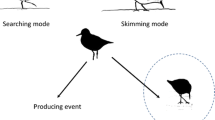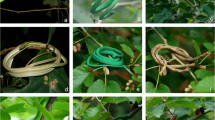Abstract
Group feeding animals experience a number of competitive foraging costs that may result in a lowered feeding rate. It is important to distinguish between reductions in feeding rates that are caused by reduced food availability and physical interactions among foragers from those caused by the mere presence of foraging companions that may be self-imposed in order to obtain some benefit of group membership. Starlings (Sturnus vulgaris) reduce their feeding rates when in the company of simulated competitors located in an adjacent cage that cannot affect the food availability or interact with the forager. In the present study, we investigate whether the presence of simulated competitors in another species of passerine, nutmeg mannikins (Lonchura punctulata), can result in self-imposed reductions in feeding rates. When feeding in the company of simulated competitors, mannikins spent more non-foraging time near them, fed more slowly, reduced travel times between patches, reduced their scanning time and pecked more slowly. These results provide evidence that simulated competitors induce a reduction in pecking rate: behavioural interference. These self-imposed responses to competitors may have resulted from attempts to remain close to the non-feeding companions. Such self-imposed reductions in feeding rates may be a widespread yet generally unrecognised foraging cost to group feeding individuals.




Similar content being viewed by others
References
Barnard CJ, Brown CAJ (1985) Competition affects risk-sensitivity in foraging shrews. Behav Ecol Sociobiol 16:379–382
Birke LIA (1974) Social facilitation in the Bengalese finch. Behaviour 48:111–22
Coolen I, Giraldeau L-A, Lavoie M (2001) Head position as an indicator of producer and scrounger tactics in a ground feeding bird. Anim Behav 61:895–903
Cresswell W (1997) Interference competition at low competitor densities in blackbirds. J Anim Ecol 66:461–471
Dubois F, Giraldeau,L-A, Grant JWA (2004) Resource defense in a group foraging context. Behav Ecol (in press)
Elgar M (1989a) Kleptoparasitism: a cost of aggregating for an orb-weaving spider. Anim Behav 37:1052–1055
Elgar M (1989b) Predator vigilance and group size in mammals and birds: a critical review of the empirical evidence. Biol Rev 64:13–33
Giraldeau L-A, Caraco T (2000) Social foraging theory. Princeton University Press, Princeton, N.J.
Goldberg JL, Grant JWA, Lefebvre L, (2001) Effects of the temporal predictability and spatial clumping of food on the intensity of competitive aggression in the Zenaida dove. Behav Ecol 12:490–495
Goodwin D (1982) Estrildid finches of the world. Oxford University Press, Oxford
Goss-Custard JD (1980) Competition for food and interference among waders. Ardea 68:31–52
Grand TC, Dill LM (1999) The effect of group size on the foraging behaviour of juvenile coho salmon: reduction of predation risk or increased competition? Anim Behav 58:443–451
Hake M, Ekman J (1988) Finding and sharing depletable patches: when group foraging decreases intake rates. Ornis Scand 19:275–279
Immelman K (1982) Australian finches in bush and aviary, 3rd edn. Angus and Robertson, London
Johnson CA, Giraldeau L-A, Grant JWA (2001) The effect of handling time on interference among house sparrows foraging at different seed densities. Behaviour 138:597–614
Lendrem DW (1984) Flocking, feeding, and predation risk: absolute and instantaneous feeding rates. Anim Behav 32:298–299
Lima SL (1995) Back to the basics of anti-predatory vigilance: the group-size effect. Anim Behav 49:11–20
Lima SL, Zollner PA, Bednekoff PA (1999) Predation, scramble competition, and the vigilance group size effect in dark-eyed juncos (Junco hyemalis). Behav Ecol Sociobiol 45:110–116
Lindstroem K, Ranta E (1993) Foraging group structure among individuals differing in competitive ability. Ann Zool Fenn 30:225–232
Livoreil B, Giraldeau L-A (1997) Patch departure decisions by spice finches foraging singly or in groups. Anim Behav 53:967–977
Pulliam HR (1973) On the advantages of flocking. J Theor Biol 38:419–422
Ranta E, Rita H, Peuhkuri N (1995) Patch exploitation, group foraging, and unequal competitors. Behav Ecol 6:1-5
Roberts G (1996) Why individual vigilance declines as group size increases. Anim Behav 51:1077–1086
Sirot E (2000) An evolutionarily stable strategy for aggressiveness in feeding groups. Anim Behav 11:351–356
Thompson DBA, Barnard CJ (1984) Prey selection by plovers: optimal foraging in mixed species groups. Anim Behav 32:554–563
Tolman CW (1965) Emotional behaviour and social facilitation of feeding in domestic chicks. Anim Behav 13:493–496
Tolman CW, Wilson GF (1965) Social feeding in domestic chicks. Anim Behav 13:134–142
Triplet P, Stillman RA, Goss-Custard JD (1999) Prey abundance and the strength of interference in a foraging shorebird. J Anim Ecol 68:254–265
Valone TJ (1993) Patch estimation: a cost of group foraging. Oikos 68:258–266
Vasquez RA, Kacelnik A (2000) Foraging rate versus sociality in the starling Sturnus vulgaris. Proc R Soc Lond B 267:157–164
Acknowledgements
This research was supported by a Natural Sciences and Engineering Research Council of Canada Research Grant to L-A.G. S.G. received additional financial support through teaching assistantships granted by the Department of Biology of Concordia University. We thank Ron Moen, Jim Grant, Paul Albert and Bill Vickery as well as members of the Groupe de discussion en écologie comportementale de l’UQÀM for commenting on an earlier version of the MS. The experiment was conducted following the guidelines of the Canadian Council for Animal Care and was approved by Concordia University Animal Care Committee.
Author information
Authors and Affiliations
Corresponding author
Rights and permissions
About this article
Cite this article
Gauvin, S., Giraldeau, LA. Nutmeg mannikins (Lonchura punctulata) reduce their feeding rates in response to simulated competition. Oecologia 139, 150–156 (2004). https://doi.org/10.1007/s00442-003-1482-2
Received:
Accepted:
Published:
Issue Date:
DOI: https://doi.org/10.1007/s00442-003-1482-2




